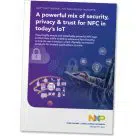Why Apple didn’t try to disrupt credit cards with Apple Pay — Fortune — “Apple’s own campus lets its employees gain access via their Apple Wallet. And next week, Apple is set to roll out student ID cards on the Apple Wallet for Duke University, the University of Oklahoma, and the University of Alabama. That feature will combine access and payments, allowing students to use their Apple Wallet ID card to enter their dorms and pay for laundry. ‘It’s a tremendous new area for us to focus on, which is really access,’ Bailey said.”
Author archive:
NXP unveils high security NFC tags that let brands deliver digitally connected products at scale

PARTNER NEWS: NXP has launched two new NFC tags that incorporate both product protection and channel authentication security features, enabling brands to take advantage of the tag reading capabilities of both Android and iOS devices to roll out NFC-based customer communication and product authentication services at scale... More
Startup tracks fine art provenance using NFC tags and blockchain registry

A New York technology company is creating a blockchain-based registry of original art and using NFC tags attached to the works themselves to link the physical items to their digital identities. More
iPhone XS packs chips for payments from NXP and ST
PARTNER NEWS: Apple’s latest iPhones, the XS and XS Max, carry an NXP 100VB27 NFC controller, according to a teardown published by iFixit... More
Huami includes NFC for travelcards, payments and access control in $116 budget smartwatch
Huami announces launch of new Amazfit Verge smartwatch — Huami — “Digital wallet functionality in conjunction with UnionPay and Alipay, combined with integrated one-touch public transportation payment in over 160 cities in China, [helps] users capture the convenience of full digital transactions (through NFC and QR codes). The Verge can be also used as entrance access device utilising NFC technology.”
Apple adds support for Express Card NFC transactions that work even when an iPhone’s battery is almost flat

Apple’s just-published iOS 12 security guide has revealed a new feature which will see owners of the latest iPhones able to conduct some NFC transactions even when the device has all but shut down because the battery needs to be charged... More
Nike adds NFC labels to Chelsea football shirts

UK Premier League club Chelsea has added NFC tags to its third kit shirts for the forthcoming football season... More
Lithuania’s MNOs open Moq NFC and QR mobile payments to public

A nationwide mobile payments system backed by three Lithuanian mobile network operators has gone into public beta testing and signed up 6,000 new users in its first 24 hours... More
Survey finds contactless payments make it harder for consumers to track their spending

A new survey has revealed that a significant minority of British consumers think that contactless payments lead to them losing track of their spending or laying out more than they intended... More
United flyers can now save boarding passes in Google Pay
Passengers flying with the world’s third largest airline can now store their boarding passes in the Google Pay mobile wallet app on their smartphones... More
Shoppers prefer Apple Pay over Walmart Pay

Walmart shoppers with access to Apple Pay are more likely to choose to use it than the store’s own Walmart Pay app, a new study has found, but those who do choose the retailer’s own app spend more at Walmart each month than those who use Apple Pay... More
Google to boost Google Pay adoption with transfer option for cards saved in Chrome
Google Chrome’s Autofill feature, which stores users’ payment card details in the browser and posts them into payment forms on websites, will soon offer to transfer details of stored cards to Google Pay... More
Russian banks begin rollout of national biometric identity system

Russia’s multi-bank remote customer identification facility, which has been in beta testing since early 2018, has launched with Know Your Customer (KYC) enrolment points now working at more than 400 banks in 140 cities... More
Apple Pay signs up 200K in Poland in first two weeks?
Just two weeks after Apple’s NFC payment system was introduced in Poland, one commentator has set out data that points to the system having already signed up some 200,000 users... More
Moscow Metro adds loyalty program to Troika transit ticketing card

Public transport users in Moscow can now earn loyalty rewards as they travel and transact around the Russian capital... More
ST launches Type 5 NFC tag chips with tamper detection and privacy features

PARTNER NEWS: STMicroelectronics has launched a family of NFC tag chips that can be read by both NFC phones and commercial RFID readers and incorporate tamper detection, anti-cloning, data protection and user privacy features... More
NFC World welcomes 120 new members from 43 countries

120 new members from 43 countries joined The NFC World Knowledge Centre in May 2018, bringing our total membership to more than 10,500 executives, technical experts and decision makers at banks, card issuers, mobile network operators, merchants, brands, device makers, regulators and policy makers around the world... More
Researchers show how invisible backdoors can be hidden in chips during manufacture
Adding backdoors at the chip level — Schneier on Security — “In this paper we propose an extremely stealthy approach for implementing hardware Trojans below the gate level… we insert our hardware Trojans by changing the dopant polarity of existing transistors. Since the modified circuit appears legitimate on all wiring layers (including all metal and polysilicon), our family of Trojans is resistant to most detection techniques.”
Apple Pay to add support for transit cards?

Apple Pay is set to add support for closed loop transit cards, issued by public transportation operators, information found in the code of the latest version of iOS suggests... More
Meet NFC World’s partners at Mobile World Congress

NFC World partners Antelop Solutions, Dejamobile, Rambus and STMicroelectronics will be at Mobile World Congress 2018 in Barcelona from 26 February to 1 March... More